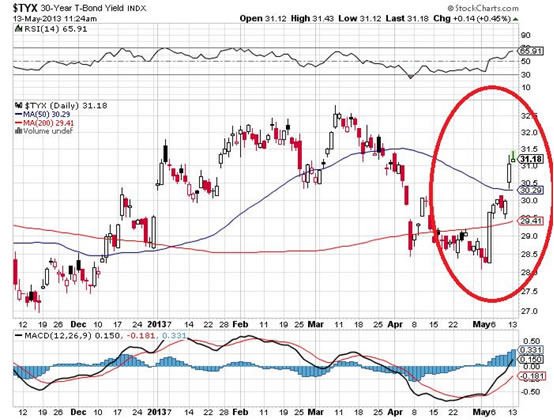Warning U.S. Treasury Bond Bull Market May Be Over
Interest-Rates / US Bonds May 15, 2013 - 02:46 PM GMTBy: DailyGainsLetter
Moe Zulfiqar writes: When the financial crisis took grip on the U.S. economy, investors fled the stock market and ran towards bonds—more specifically, high-quality U.S. government bonds. The reason behind this was very simple: they would rather invest their money in something where they knew their capital was safe than in the stock market, which was uncertain at the very best.
As a result, bond prices soared and the yields collapsed. To give you some idea: near the end of July 2012, 30-year U.S. bonds had a yield of less than 2.5%. Prior to the financial crisis, these same U.S. bonds provided investors with a yield above 4.5%.
That was the past. Now, the effects of the financial crisis are going away: the U.S. economy actually seems to be improving, the financial system is in better health, and the employment situation appears much better.
With all these changes occurring in the U.S. economy, investors are asking whether the U.S. bonds market is still a safe place to be.
According to Bill Gross, also referred to as “The Bond King” by the mainstream, the bull market in the U.S. 30-year bond probably ended on April 29. The reason: the yields reached lows and the prices peaked. (Source: Cox, P. and Leondis, A., “Gross Says Bond Bull Market Probably Ended April 29,” Bloomberg, May 10, 2013.)
Keeping this in mind, take a look at the chart below of the yields on U.S. 30-year bonds, paying close attention to the circled area:

Chart courtesy of www.StockCharts.com
Looking at this chart through technical analysis, the yields of 30-year bonds show an interesting development. Since the beginning of May, yields on the long-term U.S. bonds have been continuously increasing—meaning the bond prices are rising. To top it all off, the recent surge in yields from below 2.9% to above 3.1% has been the strongest in a while.
Furthermore, the moving average convergence/divergence (MACD) and the relative strength index (RSI), indicators of momentum and relative value, both seem to be favoring the bears. They are hinting that the yields might just continue to increase as the momentum is picking up.
From a fundamental perspective; the Federal Reserve might be halting its purchases of U.S. long-term bonds, as it has been a buyer of $45.0 billion a month. It will also eventually have to sell the bonds it has accumulated on its balance sheet, which could also cause selling pressure and a snowball effect.
Considering all this, as well as all the indicators saying we might see some weakness ahead in the bonds market, investors shouldn’t just go all-out and start to bet heavy on the end of a bull run in the bonds market. Looking at the longer-term chart, the trend is still in place with bonds prices, but the recent move might just be the turning point; remember, the trend is your friend until it’s broken.
Investors need to adjust their portfolio as the conditions change. If they react on impulse, they might be faced with losses. Investors constantly need to adjust their risk exposure and make sure they are not too invested in one asset class.
Source: http://www.dailygainsletter.com/u-s-debt/investor-beware-bull-market-in-bonds-may-be-over/867/
Copyright © 2013 Daily Gains Letter – All Rights Reserved
Bio: The Daily Gains Letter provides independent and unbiased research. Our goal at the Daily Gains Letter is to provide our readership with personal wealth guidance, money management and investment strategies to help our readers make more money from their investments.
Daily Gains Letter Archive |
© 2005-2022 http://www.MarketOracle.co.uk - The Market Oracle is a FREE Daily Financial Markets Analysis & Forecasting online publication.



